Latest news about Bitcoin and all cryptocurrencies. Your daily crypto news habit.
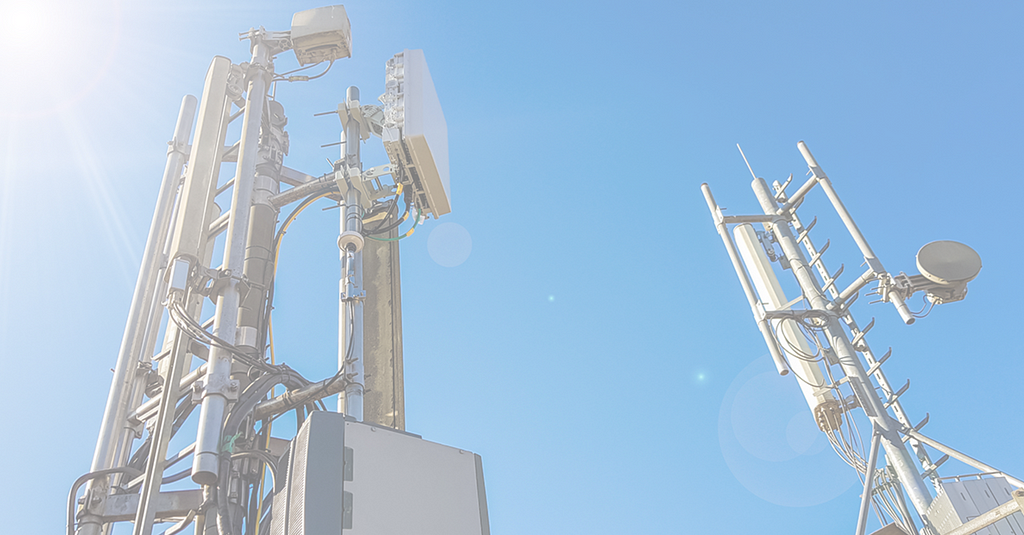 Telecom cell towers (Source: iStockPhoto)
Telecom cell towers (Source: iStockPhoto)
The advances in wireless communications has led to an exponential growth in mobile devices i.e. smartphones. The deployment of 4G and LTE (Long Term Evolution) networks has delivered us more rich content, from video streaming to live gaming. It is taking its toll on bandwidth, which now needs to be addressed as demand grows. This time around a new class of applications that are bandwidth intensive like VR (Virtual Reality), AR (Augmented Reality) and OTT will require it. The telecom industry have specified a new standard called 5G to meet the growth of network demands. High speed data communications made possible by more bandwidth sounds like an excellent business proposition for wireless carriers to expand their networks, appease users and gain more subscribers while generating more revenues.
This is also a new opportunity for developers to deploy applications that take advantage of fast, high-speed lower latency networks. Emerging technologies like self-driving cars, serverless applications, autonomous vehicles, live online gaming, IoT devices, time sensitive telemedicine and even blockchain projects have a potential to benefit from this. It may even replace home cable networks as a residential broadband service. The previous exponential growth in mobile and other computing devices can also be handled since 5G aims to provide more bandwidth. Just 20 years ago we didn’t have billions of mobile users. Now and beyond, the projections are seeing growth that have surpassed the billion mark. By 2020 there will be a projected 4.68 billion mobile users in the world. The growth is not that exponential as it begins to flatten out, but you have a large base of users from the previous years. The data just shows us how large the mobile market is and its potential for 5G use. It is not indicative of who will use 5G which I shall explain later on.
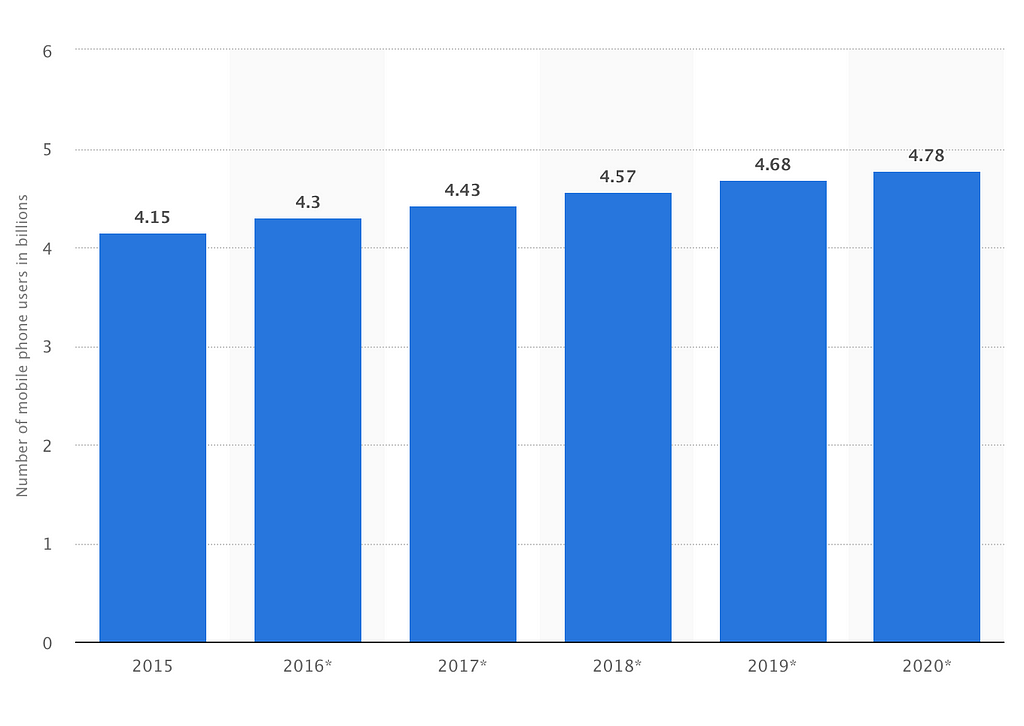 The growth in mobile users projected from 2015 to 2020 measured in billions (Source: Statista)
The growth in mobile users projected from 2015 to 2020 measured in billions (Source: Statista)
5G rollout is not without controversy though. There are always two sides to a story, and when it comes to 5G there are proponents who want to get the show on the road but there are also opponents who argue about the risk to public health and security that 5G networks may bring. Who is right and who is wrong? At this point there are more questions than answers. Let me begin by explaining what 5G is and then discuss the pros and cons.
5G Is The Next Generation Mobile Communications Standard
The wireless communications industry is introducing 5G as the successor to current 4G LTE networks. 4G used LTE and WiMax to deliver a peak speed of 100 Mbps to wireless devices. 5G has a peak data rate of 20 Gbps, using eMBB (Enhanced Mobile Broadband). That increases the bit rate which increases speed and that can also lower delays in content delivery to mobile devices. Users on facetime will have little to no lag and downloading large files will be effortless.
With faster 5G connectivity access to content will increase tremendously and speeds will increase significantly. Watching 4K UHD content on mobile devices will stream effortlessly. A doctor can have a smooth video conference with a patient with more clarity and audio fidelity. Gamers can now play more immersive video games in VR while chatting, streaming and downloading at the same time. More cloud based collaboration among peers. 5G may also facilitate the rise of smart cities and self-driving cars. These are just some of the many benefits that 5G can provide once it is rolling.
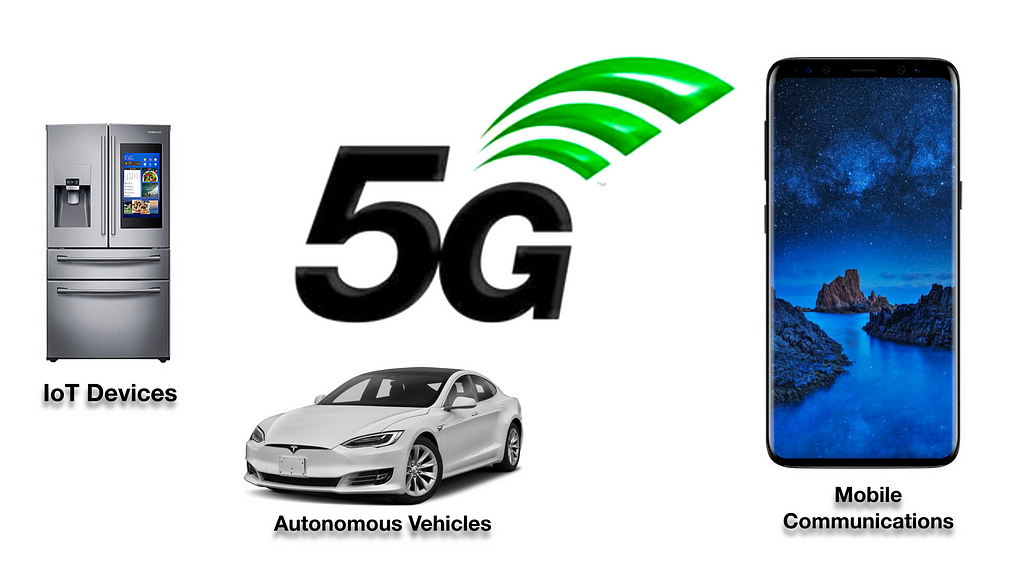 5G Networks can benefit the IoT, autonomous vehicle and mobile communications industry.Here are 5 quick things to know about 5G:#1. Short wavelength communications
5G Networks can benefit the IoT, autonomous vehicle and mobile communications industry.Here are 5 quick things to know about 5G:#1. Short wavelength communications
5G uses what are called “millimeter waves”, or short wavelength radio signals. This requires a new swath of bandwidth that is allocated on the frequency spectrum between 30–300 GHz. This increases the bandwidth available to cram more data and accommodate more users. This will require shorter wavelengths than previous networks, which means they cannot travel longer distances. These signals also cannot easily penetrate through walls and are easily absorbed by moisture and foliage. So why would engineers build a system that cannot travel far and has major drawbacks? That leads to the second feature of 5G (next item).
#2 Small Cell tower installations
To make sure that signals are able to travel farther without fading, “small cell” towers using a dense deployment will be installed within an area to handle the signaling. They will be much smaller than your typical cellular tower. These small cell towers will be placed within a distance of no less than 200 feet and no more than 1,000 feet apart, so they are pretty close to each other. The advantage to being smaller is that there is more versatility to where they can be installed. They can be put on the side of buildings, utility poles, apartment rooftops just to give a few examples. The small cells then transmit and receive data on the 5G network covering a certain area. So the idea of 5G is replacing high power, low frequency towers with low power, high frequency small cells that communicate with a base station.
#3 Beamforming Signaling System
To handle data traffic signaling, “beamforming” will be used. It determines the most efficient data delivery route in a 5G network. Beamforming actually sends the data from the small cell directly to the user. Since the signal is more concentrated, it reduces interference as well. Like its predecessor 4G, a 5G network makes use of packet switching over an IP network for data delivery.
#4 Massive MIMO
MIMO or “Multiple-Input Multiple-Output” allows more signals to be sent and received at any given moment. This is implemented by installing more antennas as an array in a small cell. The problem of having so many antennas installed is addressed by beamforming. With MIMO, a base station can send and receive more signals to boost the capacity of a 5G network by a factor of 22, first reported by engineers at the University of Bristol and Sweden’s Lund University.
#5 Full Duplex capabilities on the base station
FACT: Wireless providers don’t actually use full-duplex transceivers. In a 5G network, the use of full-duplex will allow data to be transmitted and received on base station transceivers at the same time using the same frequency. Past systems that supported full-duplex communications had to separate frequency channels to allow 2 users to communicate at the same time without having to take turns transmitting and receiving. Now it is possible using just one frequency channel through a circuit design which utilize high speed switching in the silicon. This allows antennas to transmit and receive while the incoming and outgoing signals are routed.
It looks pretty straightforward on paper. 5G is just another iteration of a wireless communication system that aims to deliver faster data speeds and handle more users. There are 2 main issues that critics are concerned about: public health and network security.
Issue № 1: “5G Can Pose A Risk To Public Health”
Activists, researchers and health professionals alike have concern for the high frequency millimeter radio signals that 5G uses. Since many small cells will be installed in close proximity to people, there must be a concerted effort to further research and evaluate the effects it could have. There are physicians who warn that the amount of radiation 5G small cells emit can have irreversible effects on people who live or are exposed to these radio waves on a daily basis.
These reports are alarming and can be a cause for fear. I don’t dismiss them at all because before any public rollout of a project there should always be an environmental impact assessment that includes public health and safety. While most critics point out the possible harm 5G can cause, there have been no significant studies that positively without a doubt prove that wireless networks have increased cancer or other illnesses. Epidemiological studies don’t have any conclusive evidence that correlates wireless and mobile use to higher incidents of diseases like cancer. We shouldn’t ignore the reports though because this is an opportunity for regulators to take a further look into 5G operation and whether it is safe to deploy.
The high frequency in question is the range 5G uses, which can go as high as 300 GHz. In the electromagnetic spectrum the range of harmful radio waves are in the gamma ray and x-ray range. The range 5G uses is in the microwave range of the spectrum. Some activists wrongly believe that 5G signals are like that used in microwave ovens. While that is true, that 5G signals are in the microwave range of the electromagnetic spectrum, there is a difference between a small cell and an oven. Microwave ovens use high energy to cook food from the inside out. Small cells use low energy to transmit and receive radio signals. They have different applications of radio waves.
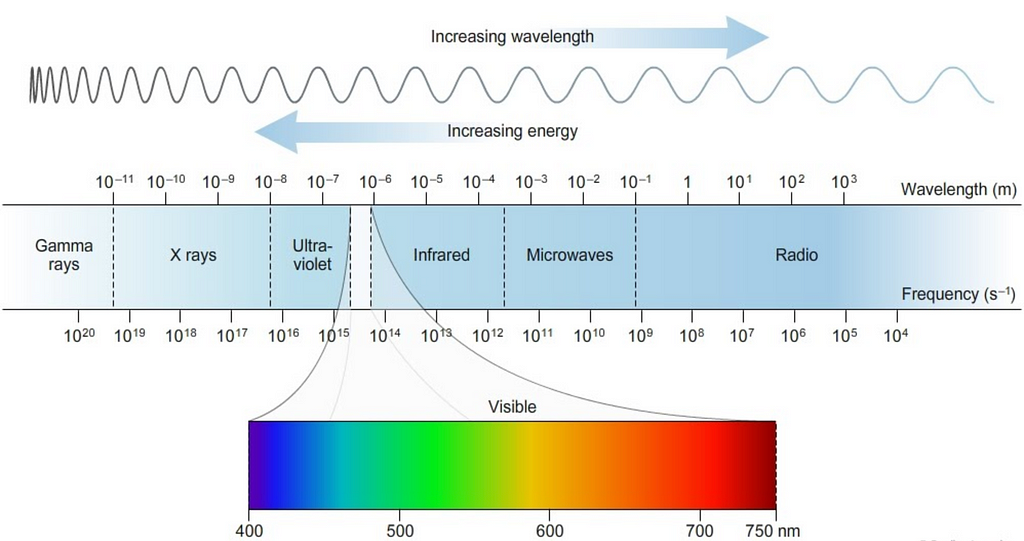 The electromagnetic spectrum showing the range of harmful radio waves (gamma rays, x-rays, ultraviolet light) and the radio waves used in telecommunications (microwave and radio).
The electromagnetic spectrum showing the range of harmful radio waves (gamma rays, x-rays, ultraviolet light) and the radio waves used in telecommunications (microwave and radio).
If you live in a sunny region like Southern California, you are already being exposed to more radiation than microwave signals from 5G. This is because visible light has a higher frequency than 5G signals and people are more exposed to sunlight. People can also get diseases from too much exposure from a component in sunlight that comes from ultraviolet rays. The range of high frequency radiation above visible light that poses dangers to health are gamma rays and x-rays aka “ionizing radiation”. Prolonged exposure causes cellular damage and also affects DNA so they are very harmful. That is why during an x-ray a patient is given special preparation and only a quick exposure to them. This is because x-rays can penetrate through skin and bone, thus we can develop them as an image on film making them highly valuable diagnostic imaging systems for healthcare. 5G signals do not penetrate human skin and bone. Most of the radiation in this range of frequencies is in the form of heat, which does not disrupt or destroy human tissue during transmission of radio waves.
More serious academics don’t argue that people are already exposed to higher frequency visible light and even infrared which is used in TV remote controls. However the issue is that when you deploy a system of 5G small cells, they are continuously transmitting wireless signals that bombard its surroundings, including people. Though 5G uses beamforming to concentrate signal transmission rather than broadcasts, critics will still want more evaluation and testing to verify the safety of 5G.
Many research reports, in general, do not find any overall harmful effects on human health from radio waves. The FCC (Federal Communications Commission) actually has strict regulations on radio waves based on the SAR (Specific Absorption Rate). The SAR is the amount of energy allowed to be absorbed by a certain part of the body that is deemed the limit for public safety. The FCC rule is that SAR level must be at or below 1.6 W per kilogram (W/kg) taken over the volume containing a mass of 1 gram of tissue absorbing the most signal. For 5G developers and telecom carriers, compliance to these standards are a must for business operations so as not to endanger the public.
The WHO (World Health Organization) states that:
“Despite extensive research, to date there is no evidence to conclude that exposure to low level electromagnetic fields is harmful to human health”
(Source: WHO About Electromagnetic Fields — Summary of Health Effects Key Point 6)
In another WHO study, we must still be cautious and proceed with research on the effects of radio waves.
“Considering the very low exposure levels and research results collected to date, there is no convincing scientific evidence that the weak RF signals from base stations and wireless networks cause adverse health effects.”
(Source: WHO Backgrounder On Base Stations And Wireless Technologies)
One report on the concerns regarding 5G can be read from an article published by Dr. Cindy Russell (Santa Clara Medical Association).
Issue № 2: “5G Has Security Problems”
There is no perfect system that is 100% secure from cybersecurity attacks. All it takes is putting a server out on a public network and it is exposed to all users, good and bad. Since 5G aims to provide a backbone that brings more speed for IoT devices in homes and businesses, it also increases the threat vectors for hackers. This is to be taken seriously since more devices will have capabilities to connect to high speed networks. That is also an opportunity for hackers to target more devices.
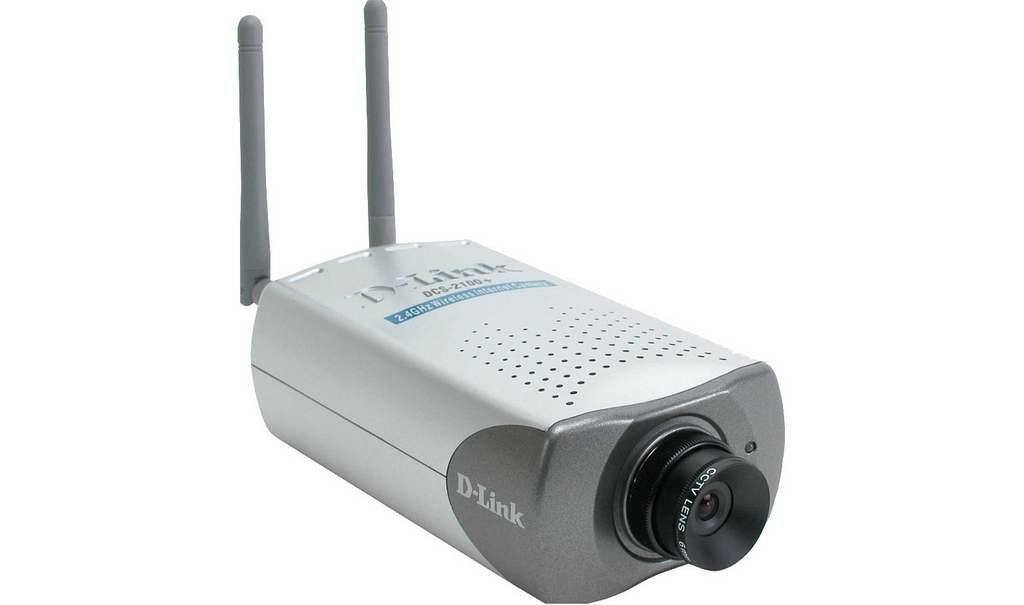 Internet cameras like this can lead to an invasion of privacy if not properly configured (Source: D-Link)
Internet cameras like this can lead to an invasion of privacy if not properly configured (Source: D-Link)
An issue with new IoT devices connected to public networks is the configuration. Some owners may just put their device online without configuring it properly. There have already been studies about the dangers of IoT due to vulnerabilities that users may not be aware of. To address these concerns, cybersecurity experts always advise users to apply updates to their IoT devices and to make sure that they don’t use simple easy to guess passwords. Despite these warnings, people still do careless things.
Faster networks can also mean faster ways for viruses and malware to spread. If more users are on the network, then you also have the potential for more infected devices and systems than ever before. This is of course a worst case scenario. 5G is just the underlying layer for applications and services. Would building a security protocol on the network like 5G be the ultimate solution? It always remains to be seen, but as of now 5G has not yet been operating on a wide scale for cybersecurity experts to identify the vulnerabilities.
 More malicious malware like “ransomware” can proliferate with more connected devices.
More malicious malware like “ransomware” can proliferate with more connected devices.
To counter the threats that faster 5G may bring, cybersecurity vendors are offering a new class of threat management and network security devices. There are now security products even for smartphones, since these devices will have the most connections to 5G networks. An AV (antivirus) installed on mobile devices like the same way they are installed on desktop computers provides a layer of defense for users by monitoring the device for any malicious activity.
There are reports that 5G has some network security issues according to Network World. In an excerpt from the article:
“One of those studies — a formal analysis of 5G authentication conducted by scientists from ETH Zurich, the University of Lorraine/INRIA, and the University of Dundee — found that criminals will be able intercept 5G communications and steal data because “critical security gaps are present,” the group says in their press release. That’s in part because “security goals are underspecified” and there’s a “lack of precision” in the 3GPP standards, they say.”
5G network operators will also have to keep a close watch for bad actors who can issue attacks on their systems. The small cell towers can even be targeted, so they must be installed in such a way that they are not easily compromised. The small cells will likely have sensors and cameras to make sure that they are not being tampered with.
5G Trials In The United States
In the US 5G deployment has been encouraged by the FCC under Chairman Ajit Pai. The FCC is paving the way for a smoother road to 5G deployment by providing the spectrum for coverage. Ajit Pai calls it the “FAST Plan” or “Facilitate American Superiority in 5G Technology.” The US will still look to modify regulations in this space as mentioned by Ajit Pai:
“But to deploy the hundreds of thousands of small cells and miles of fiber needed for 5G, we need to streamline regulations.”
Right now major telecom carriers have their own plans for 5G trials in preparation for commercial availability in 2020. One such trial that has been reported to the public is in Washington D.C. This is a project of Verizon and Nokia using the mmWave spectrum. Verizon provided the network while Nokia tested the radio equipment.
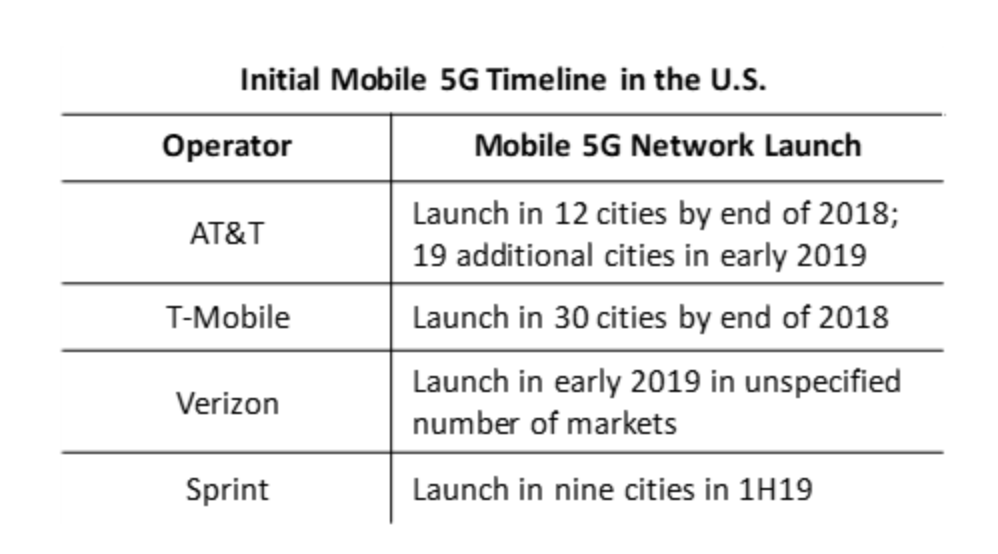 US 5G Timeline (Source: Technology Business Research, Inc.)The Road To Faster Networks
US 5G Timeline (Source: Technology Business Research, Inc.)The Road To Faster Networks
I would like to think of 5G as a fast flowing river for our digital bitstream. We now spend more time on the Internet sending e-mail, collaborating on the cloud, watching streaming content (i.e. YouTube, Netflix, Hulu, etc.) and engaging social media. Most of our data is also stored on the network and to access it requires our smartphones. With a fast network connection it no longer matters where you are, you will always have access to it. Our smartphones have become our main device since it provides us mobility to access information from anywhere.
Now going back to the user base of billions I mentioned earlier, it will still require upgrades in order to use. The current base of mobile users will not have automatic access to 5G because it will require upgrades to hardware. That means they will still need to purchase a 5G compatible smartphone or mobile device to get access to the network. With that said, there is a potential for further growth among smartphone vendors in this field. Once 5G rolls users will have to purchase new smartphones. Once again, this is going to create jobs for a growing industry as adoption widens in the transition from 4G to 5G.
The road to 5G will be faced with challenges regarding public health safety and network security. It still requires compliance for safety and operation in their respective countries. There might be interest groups who may want to capitalize or exploit this situation, which can further delay any rollout. Citizens can actually voice their concerns that would lead to stoppages of any deployment if a judge rules in their favor. There are scientific papers that support both sides of the issues. Most of the time it is business interest that wins not the scientific evidence or public confidence. We can see the benefits at this point, but not the effects. I feel these will need to be addressed in order for a more widely acceptable deployment of 5G.
 There are always bumps along the road.
There are always bumps along the road.
5G Networks Can Change The Way We Live: For Better or Worse? was originally published in Hacker Noon on Medium, where people are continuing the conversation by highlighting and responding to this story.
Disclaimer
The views and opinions expressed in this article are solely those of the authors and do not reflect the views of Bitcoin Insider. Every investment and trading move involves risk - this is especially true for cryptocurrencies given their volatility. We strongly advise our readers to conduct their own research when making a decision.